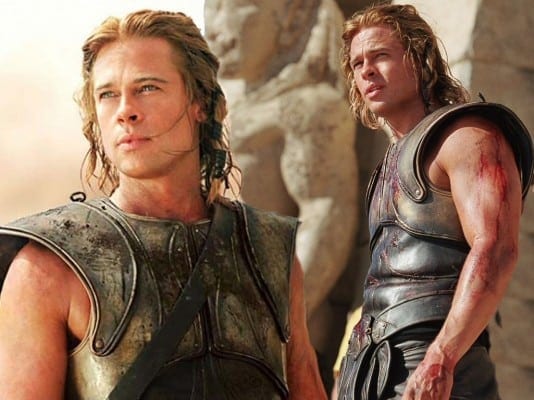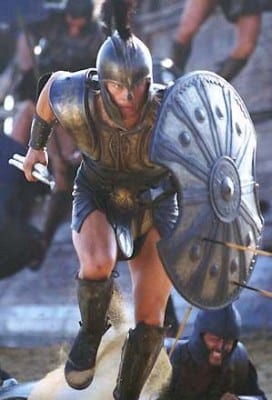MASSCULT: Hollywood and the Whitewashing of History
“The Departure of Memnon for Troy”. Black-figure vase produced in 550BC.
[dropcap]T[/dropcap]he charge that Hollywood whitewashes historical figures “of colour” is now so widely accepted as to barely require proof. From John Wayne playing Genghis Khan to Elizabeth Taylor starring as Cleopatra, Western films have honoured the tradition with almost unerring fidelity. I say almost because a few select roles are ring-fenced for non-white actors, such as Shakespeare’s Othello – the black “Moor” who murders his white wife in a fit of jealous rage.
Much to the approval of Rupert Murdoch, Ridley Scott’s epic film Exodus: Gods and Kings presents Eighteenth Dynasty Egypt as a kingdom governed by Anglo-Saxon and Celtic warriors: white Australian Joel Edgerton plays the role of Ramses II, while the white Briton Christian Bale plays Moses. This is clearly a distortion when we consider the facts that contemporaneous art, as well as written records from the historians of antiquity (such as Herodotus) are unanimous in depicting the pharaohs with  either brown or “very dark” skin. Wading into the controversy that ensued, Murdoch (a man not celebrated for his extensive knowledge of ancient African history) asked, “since when are the Egyptians not white?”
either brown or “very dark” skin. Wading into the controversy that ensued, Murdoch (a man not celebrated for his extensive knowledge of ancient African history) asked, “since when are the Egyptians not white?”
Of course, the argument that these are only films – works of art – and that “actors are simply actors, playing imaginary roles”, is a valid one. But it is valid because it rests on a post-racial, cosmopolitan view of ethnicity that makes the subject of racial difference entirely redundant. The fact that Hollywood has whitewashed Middle Eastern and African history since its early beginnings, and without interruption, makes me doubt such a view is seriously endorsed by the big studio bosses.
Indeed, the cosmopolitan view that ethnicity simply does not matter in mainstream film collapses when we consider other historical movies such as Alexander (2004). In Oliver Stone’s film, the famous Macedonian general is played by Irishman Colin Farrell, who was instructed to emphasise his whiteness by donning a blonde wig – essentially an Irishman being told to whiten up to play a Greek. Strangely, one rarely finds such enthusiasm for historical accuracy in other Hollywood movies.
Ramses II charging the Nubians.
Wolfgang Peterson’s 2004 film Troy signifies perhaps the most blatant example of Hollywood whitewashing. As part of his PR campaign, Peterson declared the film to be an accurate adaptation of Homer’s The Iliad. However, anyone acquainted with the Trojan Epics will immediately recognise the problem with this statement. Achilles does not die in The Iliad. Nor is there a wooden horse. These events only appear in other texts, such as The Aethiopis or Quintus of Smyrna’s Posthomerica. These epics also feature another major event that comes between the final scenes of The Iliad and the death of Achilles: the appearance of Memnon, the black Ethiopian king.

The Hollywood influence: Pitt’s Achilles is problematic down to his blond hair. Ancient Greeks (like modern Greeks) tend to look overwhelmingly Mediterranean. American movies have rarely cared about historical accuracy.
Reading from the source texts, we learn that “Memnon, the stout of heart, at the head of countless tribes of black men from the land of Aithiopia”, came to Troy’s defence after receiving a plea for help from his uncle, King Priam (played by white Irishman Peter O’Toole).[1] It is barely worth mentioning that Memnon is not featured in the Hollywood film (but Peterson nonetheless includes the wooden horse and the death of Achilles). What is perhaps more surprising is the degree to which the Memnon episode in the Trojan saga has been all but cleansed from the contemporary cultural imagination at large. In spite of being the subject of an entire book in the Posthomerica, the character of Memnon is omitted not only in film adaptations but in most popular accounts of the story. The fact that Troy was if not an African colony then at least part of a large alliance of kingdoms stretching thousands of miles from deep inside the African interior to the periphery of Europe (and long before the dawn of the Roman Empire), has been all but eliminated from Western cultural memory.
[dropcap]O[/dropcap]f course, such feats of historic distortion merely echo the contemporary narrative that insists Egypt was a Mediterranean colony settled by whites or near-whites – a notion contradicted by all major historians of antiquity. According to Herodotus, the Egyptians originated nearer the source of the Nile, in Ethiopia (modern Sudan). They were “dark-skinned… [with] curly hair”, and observed similar customs and traditions as the Ethiopians south of the river. [2] The “Father of History”, as he is known, also recounts the story of “forty thousand Egyptian warriors” revolting from the Pharaoh and setting out for Ethiopia, where they subsequently “gave themselves over to the king of the Ethiopians”.[3]
Sculpture of Kiya, second wife of Akhenaton.
Diodorus of Sicily adds further evidence that there was a shared culture along the Nile that originated in the south. He states that the southern cities of Egypt were founded long before those in the Nile Delta – which probably explains why all the major pharaohs, such as Ramses II, travelled south to Thebes to be coronated.[4] The fact that there are more pyramids in the Sudan than there are in Egypt, and that the peoples there worshipped the same gods, used the same hieroglyphs etc. etc., removes all doubt from the premise that what we call “ancient Egyptian culture” stretched thousands of miles along the Nile – the world’s longest river. This is a river whose source was until relatively recently the world’s largest fresh water lake in the world, lying right on the earth’s equator in Tanzania. The idea that agriculture somehow originated on the outer fringes of this region, in the far smaller and out of the way settlements of lighter skinned peoples – who mysteriously went through the ordeal of travelling thousands of miles down the Nile (northwards), crossing the Sinai Peninsula, before deciding to invent agriculture on other, smaller rivers – is very tenuous. These were settlements which, from the earliest beginnings, were overshadowed and dominated by the main superpower of the region (Egypt) and did not form empires of comparable size until thousands of years later. Nor did they construct anything as large as the Pyramids at Giza (2500 BC) or Karnak Temple, which lies further south at Thebes (3200 BC). Of course, the narrative that insists civilisation was not (or could not have been) born in Africa, which gained popularity around the same time as the eugenics movement, and often deployed the same pseudo-scientific terminology, is the one that prevails today – a narrative fit for a world that has cleansed black men from the story of Troy and insists the Pharaohs were white.
Sandstone statue of Mentuhotep II of the Eighteenth Dynasty.
The real tragedy, of course, is that the colour of such historical figures does not matter, or at least it shouldn’t. There is no pride to be found in associating oneself (or one’s “ancestors”) with tyrants and megalomaniacs like Ramses II, Achilles, Memnon, or any other “warrior king”. Indeed, the very idea of “ethnic pride” is worthy of little else but ridicule and contempt. Nevertheless, that should not make us overlook the racially-determined, and extremely distorted view of history that Hollywood has been pushing for the past hundred years, especially given that it is a view that serves to reinforce the prevailing cultural idea of white superiority.
What Hollywood has been doing, therefore, matters in this regard because none of us begins to fashion a view of history by consulting hard to find and largely neglected ancient texts. Rather, we begin the process from an early age by watching easily-accessible and entertaining Hollywood movies. These are the kind of movies that subscribe to the Murdoch view of history – the one that tells us black Africans played no role in the great story of human civilisation except in the form of slaves in the colonies. However, I have confidence that sometime in the not so distant future movies of this kind will be condemned and despised by mainstream culture to such an extent as to make their further production untenable – consigning them to the same fate as American minstrel shows. Until that time comes, we shall have to make do with making fun of Rupert Murdoch and laughing at Irishmen who wear blonde wigs.
Notes.
[1] Quintus of Smyrna, The Trojan Epic Posthomerica (Baltimore: John Hopkins, 2004), p. 25
[2] Herodotus, The Histories (New York: Palgrave, 1890), p. 134
[3] Ibid., p. 109-110
[4] See Diodorus of Sicily’s The Library of History
[printfriendly]
Remember: All captions and pullquotes are furnished by the editors, NOT the author(s).
What is $5 a month to support one of the greatest publications on the Left?





